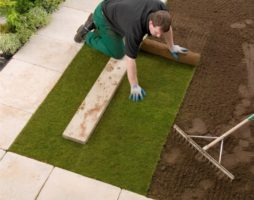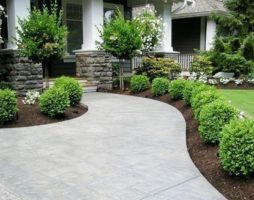The dream of a landscaped suburban area may well become a reality. A house territory with luxurious lawns, a beautiful garden, a productive garden, gazebos, patios, alpine slides - all this today can be arranged on soil of any quality and lands of any geodetic complexity, the main thing is to approach the decision correctly and do not forget about such a procedure as site drainage.
This system is expensive, so in order not to get into a mess and not pay twice, you should figure out whether the existing landscape needs drainage, and if so, what type.
Why do you need drainage on the site
What are the functions of drainage? The tasks of the system are as follows:
1. Collection of melt water.
2. Rainfall drainage.
3. Removal of groundwater outside the boundaries of the territory.
It is not always advisable to comprehensively drain the soil, laying deep and surface drainage at the same time. Deep drainage systems are required only for swampy soil and those lands where the groundwater level is high. Linear drainage will not be superfluous anywhere. Seasonal flooding is characteristic of any climatic zone. In addition, the quality of our soil, in general, leaves much to be desired. Clay soils have poor permeability, which also provokes the formation of puddles.
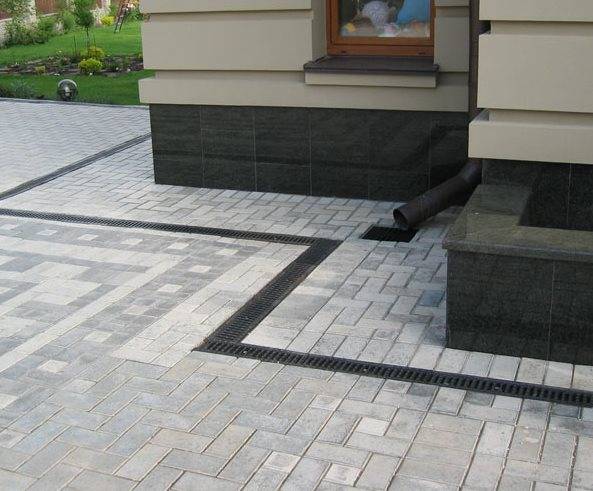
Linear drainage to prevent puddles
Flooded territories are death not only for plants, but also for wooden buildings and decorative structures. At best, they will have to be seriously repaired. At worst, demolish and install new ones. Both situations are financially costly, and given that without a drainage device on the site, there is a prospect of doing global reconstructions regularly, then it makes sense to think about preventing water stagnation.

Site deep drainage system
When Site Drainage Is Necessary
It will be necessary to deal with the organization of drainage from the ground, provided that the summer cottage is located on a steep slope. In order to prevent the fertile part of the soil from being blown away by storm flows, it will be necessary to break a surface, but not a point, but a linear drainage system with transversely broken channels capable of intercepting water and redirecting it to a storm sewer.

Drainage of a site on a slope
The reason to do the drainage device on the site with your own hands will be placing it in a lowland. In this case, it is initially a reservoir for collecting water flowing to it. In this embodiment, drainage elements are located along the perimeter of the territory.

Drainage of a site located in a lowland
No less a scourge and flat areas where water is poorly absorbed by the soil. This is where you need to design a whole system of point or linear drainage systems covering the entire area.
The fact that the site needs to be drained will be told by gathering and standing puddles for a long time. Examine the lawn. Assess the condition of the bushes. Check if the soil is blocking. These hints are effective in already inhabited territories. On the virgin lands, you will have to focus on what is happening in the district.Have the neighbors prepared a foundation pit for the house and dug holes for the fence posts? Fabulous! Look into them. If there is an accumulation of water inside, try to figure out where it flows from. Ask the old-timers the level of standing water in the wells over the past few years. If it turns out that groundwater lies less than a meter from the surface, then it is most likely impossible to do without a drainage device on the site.

Point drainage system
Surface drainage
"Drainage can be done with linear or chiseled drainage"
The simplest solution. The surface system provides collection of water from drains and the territory of the site. By providing free runoff paths for rainfall, it saves the soil from waterlogging.
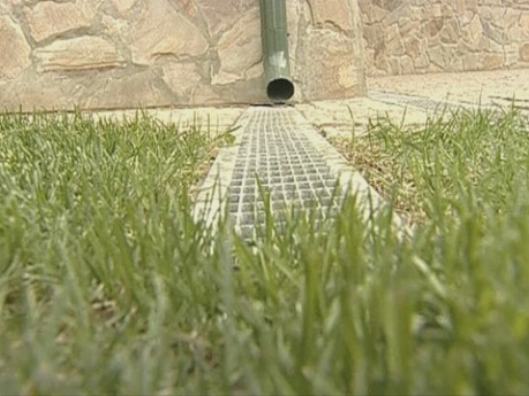
Surface drainage ensures the collection of water from the site
To equip such a drainage site with your own hands, you do not need to involve specialists. There will be no large-scale work. Drainage can be done with a linear or chiseled drainage system. Point drains are responsible for the local collection of moisture. It can be drains from roofs, water from irrigation taps. For drainage of large areas, it is correct to break the linear drainage system.
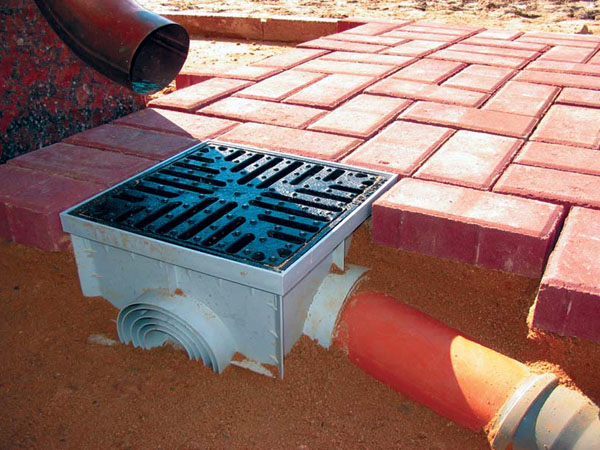
Point drainage is responsible for the local collection of moisture
Surface drainage methods
An open drainage system can consist of both randomly generated grooves and parallel ones. Each scheme has lateral supplies that carry water that has fallen into the drainage to the central drain. Which type of surface drainage device to give preference to should be chosen according to the type of soil and topographical conclusions.
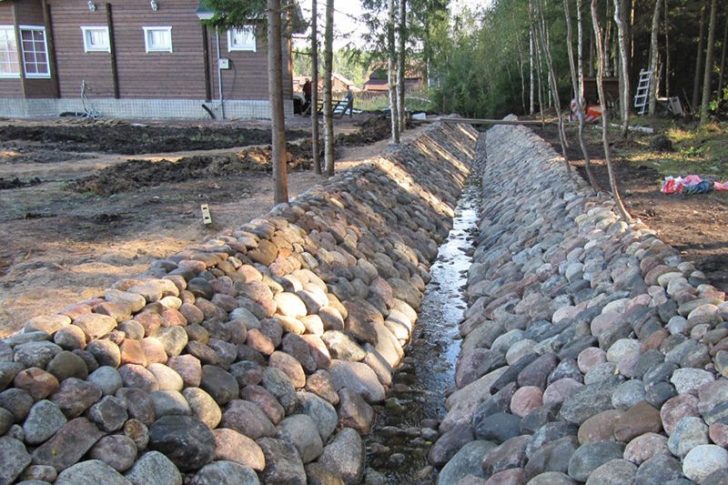
Open drainage channel
Drainage on a plot of random type
The ditches of such storm drains are adapted to collect water from the soil of low permeability, where there are extensive low-lying areas of stagnation, the elimination of which by smoothing the surface is impossible or unprofitable.
By and large, random linear drainage is the prerogative of the fields. The ditches scattered across the field do not differ in scale. Most often they are quite small and do not intersect with the main sewerage lines.
The task of random grooves is to ensure the outflow of moisture accumulated in low-lying islands. To make random drainage of the site with your own hands, it is enough just to dig small grooves with the appropriate slope angle. The earth extracted at the same time can be used for filling small lowlands.
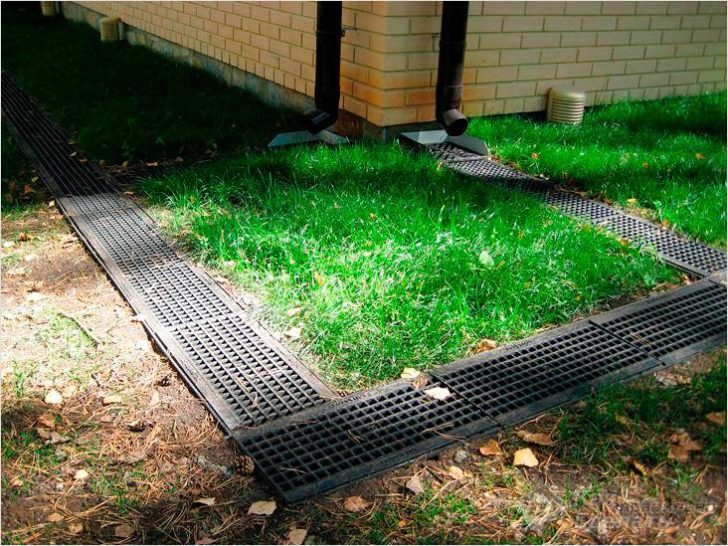
Linear drainage will ensure the outflow of accumulated moisture
Field storm channels should follow through the main mass of depressions towards the natural slope of the site. Only in this way will the territory be guaranteed full drainage.
Drainage in a section of parallel type
It is rational to equip this type of drainage system on flat, difficult to dry soils with numerous small depression flaws. The parallel arrangement of the grooves does not indicate their equidistance. Stepping distance depends on soil conditions.
Closed drainage
This category includes deep drainage of the site, which helps to reduce the standing groundwater level. It is classified as a horizontal type dehumidification system.

Deep drainage helps to reduce standing water tables
Closed drainage structures are universal. With no less efficiency than surface drainage, they can drain melt and storm water. Since the system is hidden underground, it does not interfere with landscaping, which makes it quite popular among gardeners.
vertical drainage
The main elements of this type of drainage system are wells, traditionally equipped near the house. The outflow of water accumulated in them occurs with the help of pumps.
Drainage of a site of this type is carried out only according to a professionally drawn up project.Without engineering knowledge and specific skills, you should not take on the drainage device on the site with your own hands. The work will require the involvement of specific hydraulic equipment, so leave this task to those who know exactly how to do it.
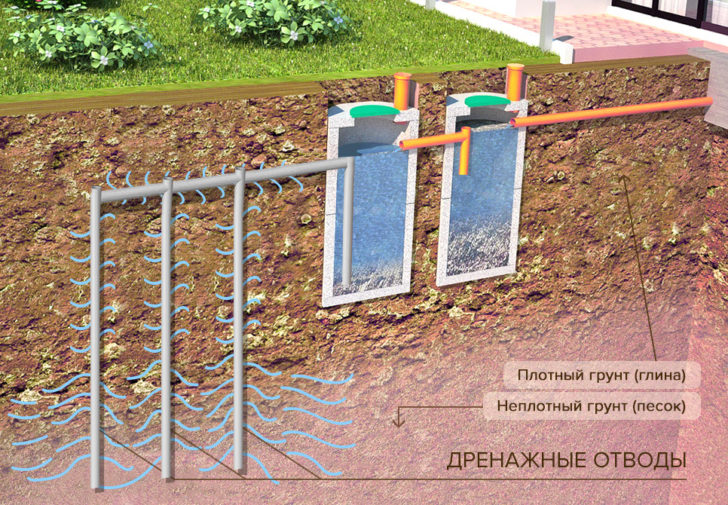
Site vertical drainage system
Do-it-yourself site drainage: the main nuances
The choice of the type of drainage system is mainly influenced by the cause of the flooding of the territory. Clay lands, which are characterized by the retention of melt and atmospheric water, can be put in order by equipping surface drainage. Open-type drainage grooves will be quite enough to quickly remove excess moisture from the serviced area.
If the reason for flooding the basement, erosion of the foundation, swelling of the soil is groundwater, then the problem will have to be solved with a thorough approach, that is, by deep drainage of the soil. Both options for the drainage device on the site are available in an independent version.
Point drainage
To create a local open drainage network, it is not necessary to draw up a design scheme. Its arrangement is natural in the case when the flooding of the site occurs only at certain points and only when excessive precipitation occurs. Gentle areas are most often flooded: the area near the porch, gazebos. It is guaranteed that water will accumulate in relief irregularities.
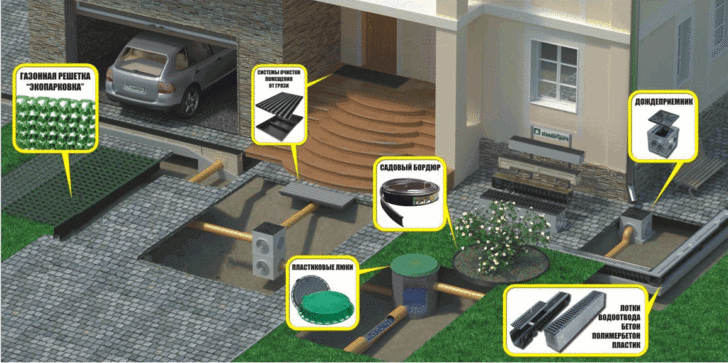
Places for mounting a point drainage system
In the event that the problem area is located near the very borders of the land, it is rational to equip the drainage on the site with a conventional dug trench that extends beyond its boundaries to ensure runoff.
In steel cases, having noticed the places of stagnant water, they are equipped with dug-in water intakes or closed tanks. The water collected in them, later it will be possible to water the garden.
Linear drainage
"Ensuring the smooth operation of the surface drainage system is due to the calculation of the correct slope of laying the sewers"
Digging ditches through the entire area or certain corners of it is the best way to drain clay soils. Here it does not hurt to sketch out a rough plan for the future system, on which to mark all the drainage branches and the location of the drainage well, to which it is planned to reduce them.
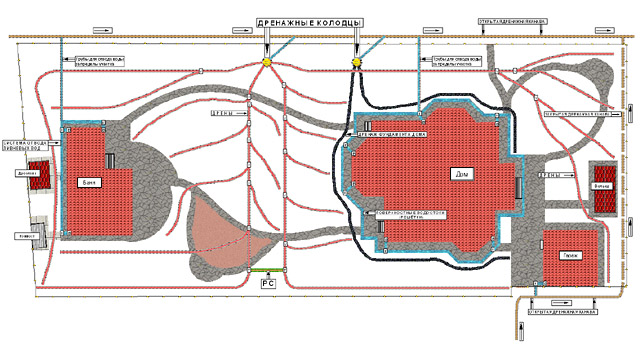
Example of a linear drainage plan
Ensuring the smooth operation of the surface drainage system occurs due to the calculation of the correct slope for laying sewers. The process of arranging linear drainage systems will be greatly facilitated by the presence of a natural slope near the site. On flat surfaces, you will have to create an angle of inclination artificially. This condition is mandatory. Ignoring it will cause the collected water to stagnate in the drainage channels.
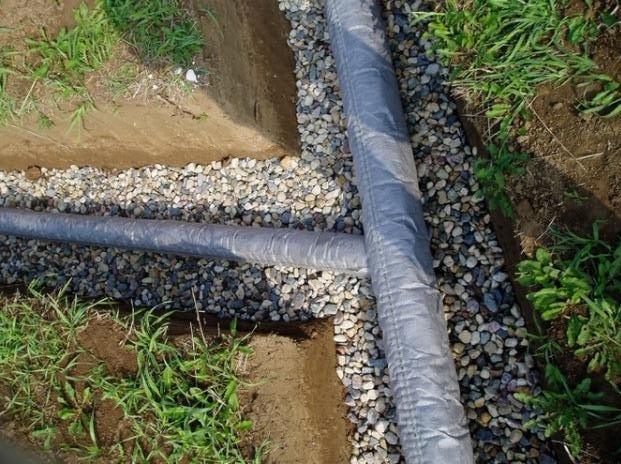
For linear drainage on a flat surface, create a slope angle
How much to lay channels is determined by the absorbency of the soil. The more clayey it is, the denser the drainage network is branched. The depth of the trenches dug for drainage of the site with their own hands is about half a meter. The width of the groove depends on its distance from the storage tank. The widest will be the main branch of the drainage system, where water flows from all parts of the site.
After the drainage system at the site has been dug, they begin to check the quality of its functioning. To do this, a strong stream of water is launched through the irrigation hoses through the channels. Properly supply water from several points at the same time.
Evaluation is done by eye. If the water drains slowly and accumulates somewhere, you will have to correct the slope and perhaps even widen the groove.
After making sure that the drain is ideal, you can start decorating the drainage area. The view of open ditches is unaesthetic.When working on a drainage device on a site with your own hands, it is easiest to arrange it with different fractional gravel. At the bottom of the grooves, you can put larger elements of stones and sprinkle small ones on top. If desired, the last layer is made of marble chips.
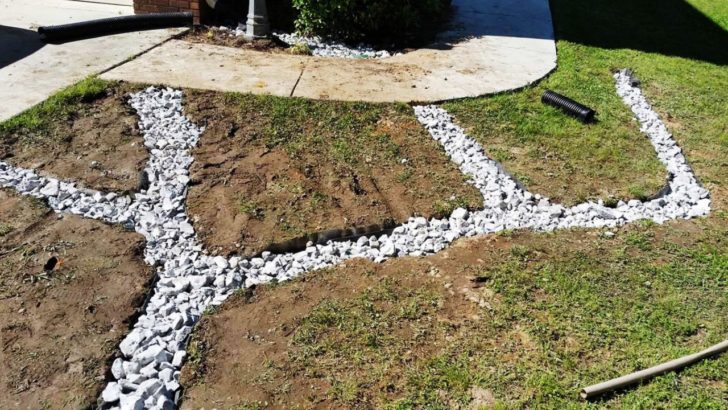
Linear drainage decoration
If this is not available, replace the material with decorative gravel. What does this mean? Having selected a part of fine gravel, it is painted in blue colors, it can be of different shades. By pouring it into the channels of linear drainage systems, you will get the illusion of running water. For a complete association with streams, plant the banks of ditches with flowering plants. Thus, you will get not just a functional drainage system, but also a luxurious design element.
Channels dug along the perimeter of the site are often covered with a decorative lattice.
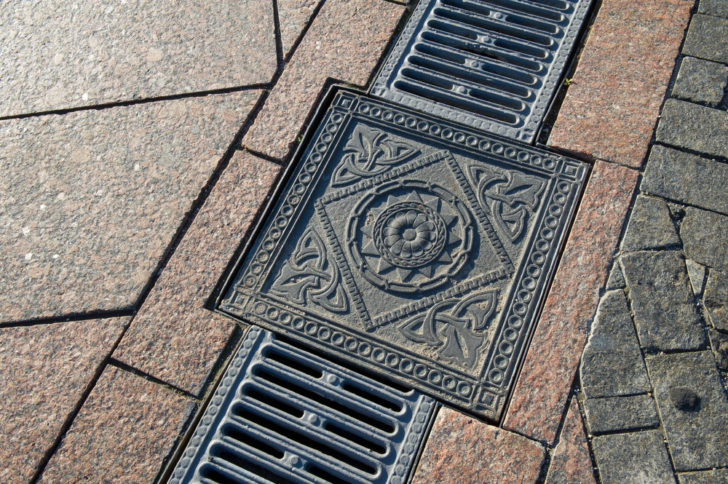
Decorative grating for drainage channel
Filling surface drainage with gravel is not only a matter of aesthetics. In fact, it is also an opportunity to strengthen the walls of the ditches, preventing them from crumbling, and also to protect the bottom from being washed out. Therefore, by using gravel backfill, you will extend the operational life of your drainage system.
Service features
When caring for surface drainage, special attention is paid to the cleanliness of the outlet channels. Even small build-ups on the walls and bottom can cause a decrease in operating efficiency. Drains are inspected after each rainstorm. All obstacles that appear in the way of the drain must be removed.
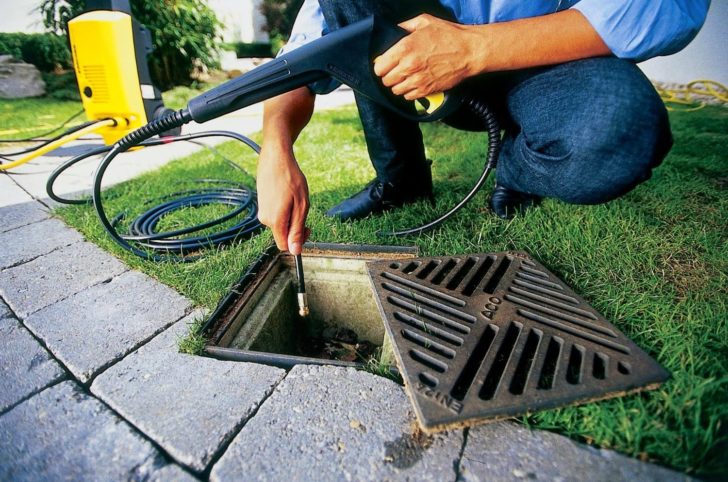
Drainage system needs regular cleaning
The second moment will be the control of the slope angle of the linear drainage elements. When smoothing it, you will have to adjust the bottom of the channel by digging or backfilling.
The point drainage is cleaned manually.
Do-it-yourself deep drainage of the site
If the problem of waterlogging is not in super clay soil, but in close-lying groundwater, then the development of a closed drainage system will have to be puzzled. The types of work are arranged in the following order:
1. Understanding the depth of laying drainage pipes on the site. This indicator is affected by the density of the earth. The higher its numbers, the less deep the drainage. Let's look at an example. Drainage pipes are immersed in sandy soil by at least a meter; for loams, this parameter is already 80 cm. In clay soils, pipes are located no deeper than 75 cm. Why can't drains be laid higher? In addition to soil density, there is another indicator. It's about the depth of its freezing. The drainages you are laying should lie below this mark, then the pipes will not be deformed.

Example of a deep drainage device
2. Choose the type of pipes. If surface drainage can be saddled without any specific conductors at all, then for deep drainage, a drain section will have to be purchased. What does the current range offer? Drainage elements of the system are manufactured:
- made of plastic;
– ceramics;
- asbestos.
Ceramic pipes are quite expensive for drainage on the site, but they will last for centuries. There are farmsteads where the covered drainage of the area made of ceramics has been functioning for 150 years. Asbestos-cement products, although durable, are practically not used today due to their environmental insecurity.
At the peak of popularity, inexpensive and practical perforated plastic. As part of the deep drainage of the site, the pipes from it will need additional protection from clogging with small soil particles. If this is not taken care of initially, then after a very short time, the drains will clog and stop letting water through.
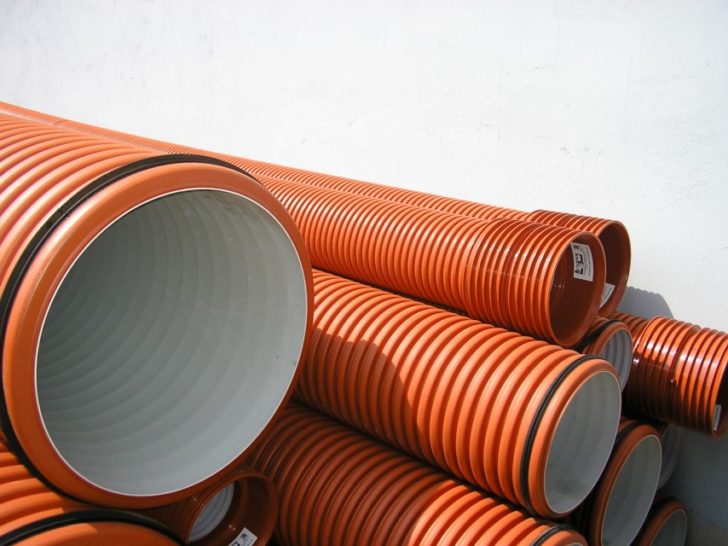
Perforated plastic pipes for drainage
It is good to use geotextiles to isolate the drainage pipes of the site. It is possible not to wrap the drains with filter material only in clay soil. Here it will be enough to lay the pipe on a twenty-centimeter layer of gravel.In loam, this option will not work. Pipes will have to be wrapped in geotextile fabric. Worst of all will be the owners of sandy areas. Here, the components included in the deep drainage device of the site will have to be not only wrapped with geotextiles, but also covered from all sides with a thick layer of gravel.

Arrangement of drainage using geotextiles
If there is a goal - to make high-quality drainage of the site with your own hands and you have certain skills to implement it, focus on drainage systems made of stone or brick. Their creation is more difficult and expensive, but the efficiency of functioning is simply excellent.
3. Prepare a place for water inlets. Before digging, you need to decide where the drains will carry the collected water. The pipe can simply be taken out of the site, and the water can be drained into a ditch dug there, or a drain well can be built for this purpose, similar to point drainage systems. The second option is more practical. In a dry year, water from it can save the crop, and it is rarely possible to remove drainage from the site.
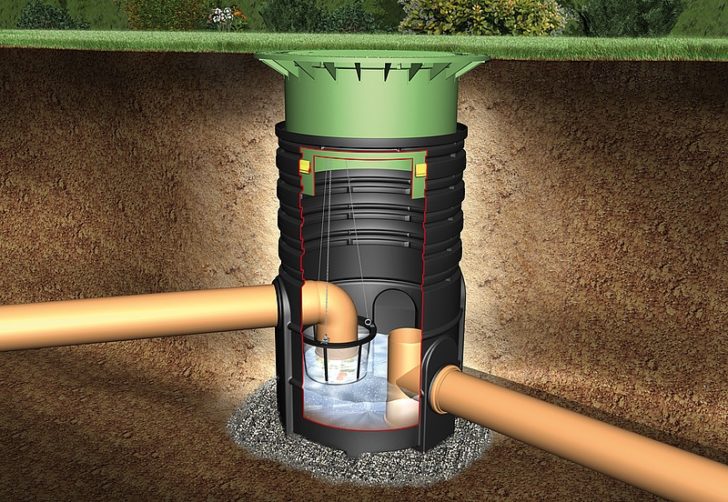
Water intake device
4. Earthworks begin. Digging ditches when arranging drainage on the site goes along an inclined path to the well. Each subsequent meter of the moat deepens by 7 cm. The slope angle is controlled by a level. It is optimal to arrange system drains in a herringbone pattern. In this case, all branches of the linear drainage system will depart from one central pipe having a larger diameter.
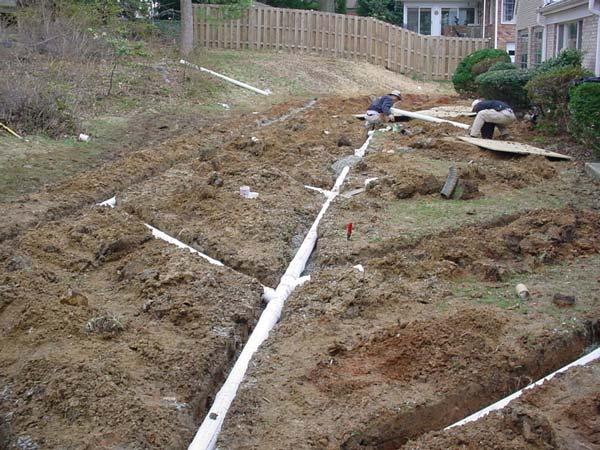
earthworks
5. Prepare the bottom of the channels for laying drains. When the network of ditches is dug, it is necessary to start leveling their bottom. There should be no sharp drops in the trenches. The presence of break points will cause the plastic drainage elements in the area to deform under the weight of the soil. The easiest way to solve the problem is to create a shock-absorbing pillow. It is made from large fractional sand and gravel. Both materials fall asleep to the bottom in equal layers. Pipes are laid on gravel. If there is no possibility of backfilling, the groove can be lined with several layers of geotextile.
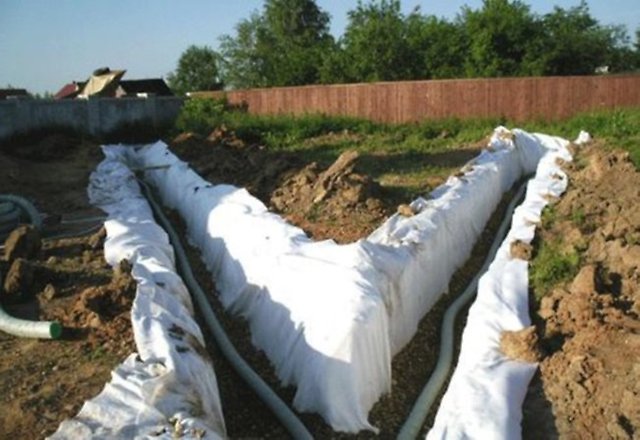
The bottom of the channel is lined with geotextiles
When choosing filter cloth, look for low density products. High-density geotextiles will make it difficult for water to seep through and make even very well-thought-out site drainage ineffective.
6. Assemble the system. All pipes are laid out in trenches and connected into a single network by means of crosses and tees.
Deep drainage of the site is ready. It remains to fill the ditches with a sand-gravel cushion and soil, forming earthen ridges above the places where the pipes pass. This is necessary so that during the shrinkage of the layers in these areas, lowlands do not form.
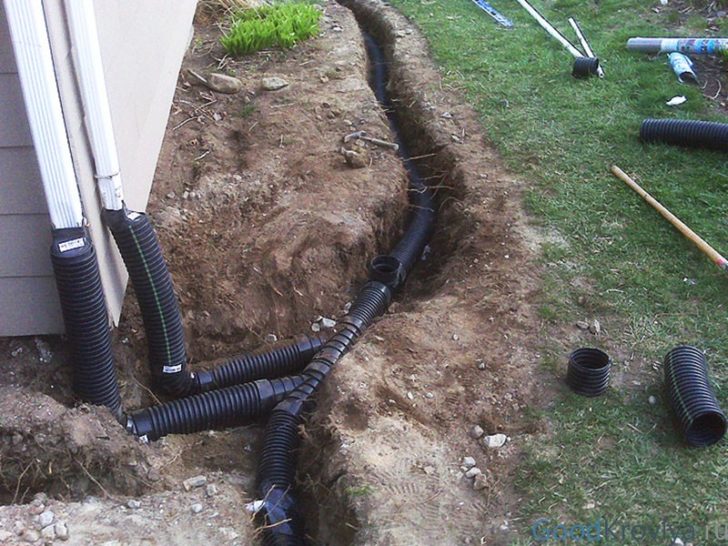
Assembly of the site drainage system
After the drainage at the site is equipped, it is not recommended to pass through it with heavy equipment. You can deform the system.
Experts advise starting soil drainage work after the completion of the main construction activities, since restoring or reconstructing the deep drainage of a site is much more difficult than laying a new one.
back to index ↑Features of care
Caring for surface drainage on the site, in comparison with closed structures, will seem like easy fun. With deep systems, everything is more complicated. Here you will have to monitor not only the patency of the pipes, but also the cleanliness of the wells. The latter are often clogged with leaves and other debris. If sediment is found in the tank, it will need to be removed using a sand trap or washed out with water and pumped out with a pump.
Once every five years, the drainage device at the site must perform a full preventive flushing of the drainage pipes. For high-quality performance of the procedure, it is better to invite specialists.
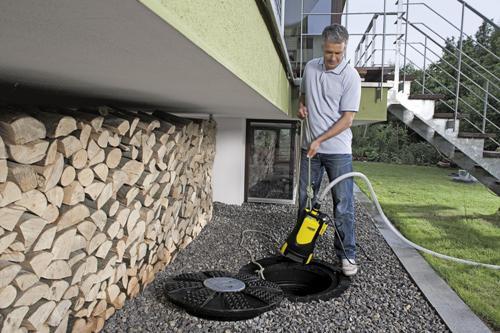
Flushing the drainage system
If you have the equipment, you can try to flush the drainage yourself.To do this, install a drainage pump in the well, which will remove the incoming water from it, and then feed its high-pressure flow into the pipes.
back to index ↑Conclusion
Drainage on the site is not a luxury. This is an absolutely necessary procedure for protecting the soil. Whether to work on the drainage of the site with your own hands or involve professionals in the process, you choose. The main thing is that the system is correctly mounted, and its type corresponds to soil problems.
Video


